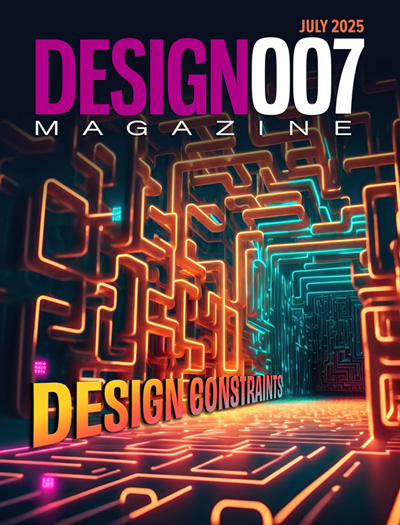-

- News
- Books
Featured Books
- design007 Magazine
Latest Issues
Current Issue
Signal Integrity
If you don’t have signal integrity problems now, you will eventually. This month, our expert contributors share a variety of SI techniques that can help designers avoid ground bounce, crosstalk, parasitic issues, and much more.

Proper Floor Planning
Floor planning decisions can make or break performance, manufacturability, and timelines. This month’s contributors weigh in with their best practices for proper floor planning and specific strategies to get it right.

Showing Some Constraint
A strong design constraint strategy carefully balances a wide range of electrical and manufacturing trade-offs. This month, we explore the key requirements, common challenges, and best practices behind building an effective constraint strategy.
- Articles
- Columns
- Links
- Media kit
||| MENU - design007 Magazine
Design Community Town Hall Review
April 11, 2024 | Kelly Dack, CID+, EPTACEstimated reading time: 2 minutes
There’s been a lot of work going on at IPC related to PCB design training and education. This week, many new members of IPC’s design groups met up in person at IPC APEX EXPO.
The Design Community Town Hall took place on the afternoon of April 10, 2024. I was fortunate to attend this event, which marked an opportunity for members of some newly found design groups to get together and exchange ideas. Peter Tranitz, senior director of solutions for IPC, opened the session with a slide presentation introducing these new groups and members within the solutions department.
The Design Leadership Council includes 14 members:
Steve Watt (Zuken), Steven Roy (Optimum Design Associates), Dale Lee (Plexus), Pietro Vergine (Leading Edge), Savita Ganjigatti (Sienna ECAD Technologies), Thomas Romant (IPC Designers Council France), Ellefen Jiang (NCAB), Kevin Kusiak (Lockheed Martin), Susan Kayesar (Siemens), Jesus Castane (MBDA), John Watson (Altium), Igor Bulavitchi (Flex), Flayover Guo, and Huseyin Ariac.
The Global IPC Internal Design Team (GIDT) includes 16 members:
Matt Kelly (Sponsor), Mike Milostan (Marketing), Barry Matties (I-Connect007), Andy Shaughnessy (I-Connect007), Carlos Plaza (Education), Teresa Rowe (Standards), Kelly Scanlon (Sustainability), John Perry (Standards), Peter Tranitz (Initiative Coordinator), Patrick Crawford (Standards), Francisco Fourcade (Standards), Andres Ojalill (Standards), Kris Moyer (Education), Lorena Villanueva (Mexico), Shine Yang (China/Asia), and Saurabh Saxena (India).
These new groups are poised to tackle a variety of challenges as IPC pivots to fill gaps in the design and manufacturing knowledge pool due to the ongoing retirement of our senior subject matter experts.
Tranitz then extended “kudos” to these group members. He emphasized that their “1,000 years of combined knowledge” will come in handy as the groups work and collaborate going forward. He emphasized the need to address critically needed updates in educational training programs as well as design and manufacturing standards and guidelines.
The second half of the meeting included a panel discussion moderated by Susan Kayesar, product manager for PCBflow at Siemens. The panel focused on some soon-to-be published white papers on several key design topics involving CAD data, DFM and stakeholder usage and accessibility. The event wrapped up with a rousing Q&A session. PCB designers and design engineers in the audience were not shy about sharing their opinions.
If you’re a subject matter expert on PCB design, consider getting involved with IPC’s design teams. They will welcome you with open arms, and you’ll probably learn something along the way.
Testimonial
"We’re proud to call I-Connect007 a trusted partner. Their innovative approach and industry insight made our podcast collaboration a success by connecting us with the right audience and delivering real results."
Julia McCaffrey - NCAB GroupSuggested Items
Accelerating Embedded Innovation: Orthogone Becomes Texas Instruments Design Partner
09/17/2025 | PRNewswireOrthogone Technologies Inc., a leader in advanced embedded systems and FPGA development, is proud to announce its official designation as a Texas Instruments (TI) Design Services Partner.
BLT Joins Microchip Partner Program as Design Partner
09/17/2025 | BUSINESS WIREBLT, a U.S.-owned and operated engineering design services firm announced it has joined the Microchip Design Partner Program.
Staying on Top of Signal Integrity Challenges
09/16/2025 | Andy Shaughnessy, Design007 MagazineOver the years, Kris Moyer has taught a variety of advanced PCB design classes, both online IPC courses and in-person classes at California State University-Sacramento, where he earned his degrees in electrical engineering. Much of his advanced curriculum focuses on signal integrity, so we asked Kris to discuss the trends he’s seeing in signal integrity today, the SI challenges facing PCB designers, and his go-to techniques for controlling or completely eliminating SI problems.
American Standard Circuits to Exhibit and Host Lunch & Learn at PCB West 2025
09/17/2025 | American Standard CircuitsAnaya Vardya, President, and CEO of American Standard Circuits/ASC Sunstone Circuits has announced that his company will once again be exhibiting at PCB West 2025 to be held at the Santa Clara Convention Center on Wednesday, October 1, 2025.
ASM Technologies Limited signs MoU with the Guidance, Government of Tamilnadu to Expand Design-Led Manufacturing capabilities for ESDM
09/15/2025 | ASM TechnologiesASM Technologies Limited, a pioneer in Design- Led Manufacturing in the semiconductor and automotive industries, announced signing of Memorandum of Understanding (MoU) with the Guidance, Government of Tamilnadu whereby it will invest Rs. 250 crores in the state to expand its ESDM related Design-Led Manufacturing and precision engineering capacity. ASM Technologies will acquire 5 acres of land from the Government of Tamilnadu to set up a state-of-the-art design facility in Tamil Nadu's growing technology manufacturing ecosystem, providing a strong strategic advantage and long-term benefits for ASM.


